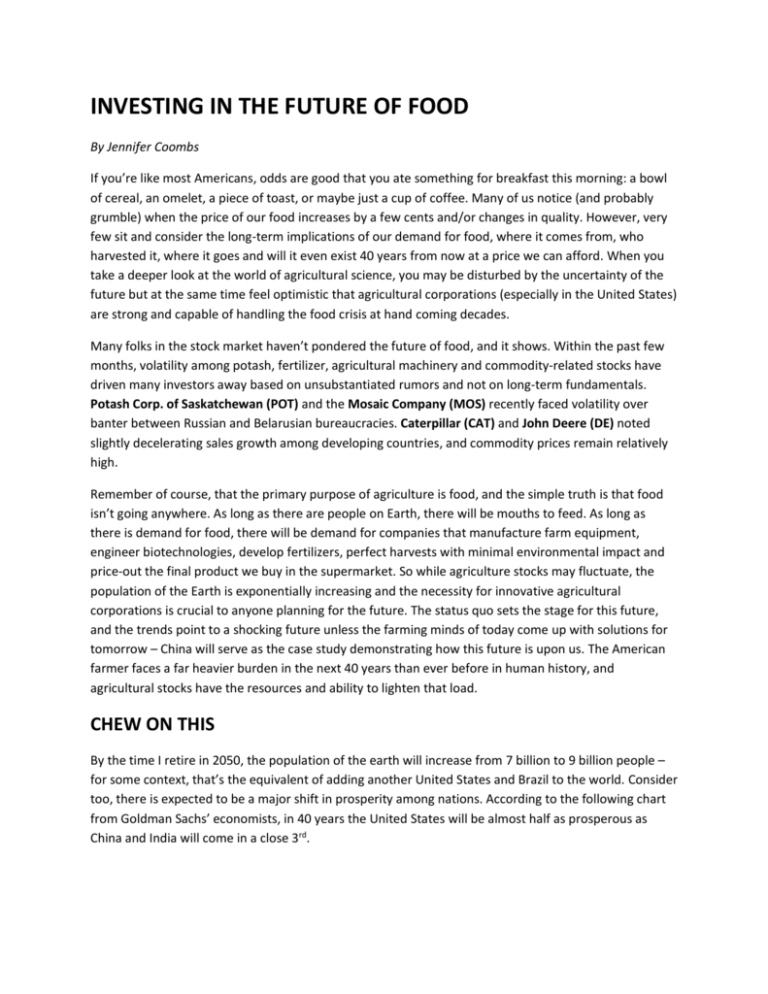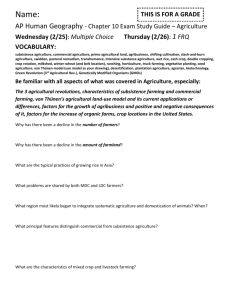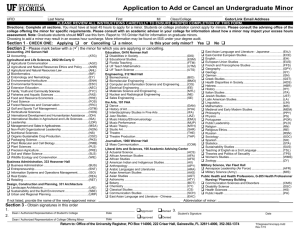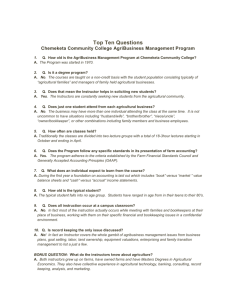INVESTING IN THE FUTURE OF FOOD
advertisement

INVESTING IN THE FUTURE OF FOOD By Jennifer Coombs If you’re like most Americans, odds are good that you ate something for breakfast this morning: a bowl of cereal, an omelet, a piece of toast, or maybe just a cup of coffee. Many of us notice (and probably grumble) when the price of our food increases by a few cents and/or changes in quality. However, very few sit and consider the long-term implications of our demand for food, where it comes from, who harvested it, where it goes and will it even exist 40 years from now at a price we can afford. When you take a deeper look at the world of agricultural science, you may be disturbed by the uncertainty of the future but at the same time feel optimistic that agricultural corporations (especially in the United States) are strong and capable of handling the food crisis at hand coming decades. Many folks in the stock market haven’t pondered the future of food, and it shows. Within the past few months, volatility among potash, fertilizer, agricultural machinery and commodity-related stocks have driven many investors away based on unsubstantiated rumors and not on long-term fundamentals. Potash Corp. of Saskatchewan (POT) and the Mosaic Company (MOS) recently faced volatility over banter between Russian and Belarusian bureaucracies. Caterpillar (CAT) and John Deere (DE) noted slightly decelerating sales growth among developing countries, and commodity prices remain relatively high. Remember of course, that the primary purpose of agriculture is food, and the simple truth is that food isn’t going anywhere. As long as there are people on Earth, there will be mouths to feed. As long as there is demand for food, there will be demand for companies that manufacture farm equipment, engineer biotechnologies, develop fertilizers, perfect harvests with minimal environmental impact and price-out the final product we buy in the supermarket. So while agriculture stocks may fluctuate, the population of the Earth is exponentially increasing and the necessity for innovative agricultural corporations is crucial to anyone planning for the future. The status quo sets the stage for this future, and the trends point to a shocking future unless the farming minds of today come up with solutions for tomorrow – China will serve as the case study demonstrating how this future is upon us. The American farmer faces a far heavier burden in the next 40 years than ever before in human history, and agricultural stocks have the resources and ability to lighten that load. CHEW ON THIS By the time I retire in 2050, the population of the earth will increase from 7 billion to 9 billion people – for some context, that’s the equivalent of adding another United States and Brazil to the world. Consider too, there is expected to be a major shift in prosperity among nations. According to the following chart from Goldman Sachs’ economists, in 40 years the United States will be almost half as prosperous as China and India will come in a close 3rd. In the meantime, the United States still dominates in agricultural capabilities and practices in the global market; currently one US farmer feeds approximately 155 people worldwide (by comparison 1 American farmer fed about 26 people worldwide in 1960). By the year 2050, they will need to double production to keep pace. Currently, the US uses a massive 41.4% of its landmass for farming but only possesses roughly 4% of the world population. By comparison, 20% of all the mouths on earth to feed reside in China and must rely on less than 10% of the country’s total mass for farming. Obviously, the demand far exceeds the supply and the problem continues to grow. China is rapidly becoming a consumer society, but the world’s largest manufacturing center can’t keep manufacturing without food to feed its workers and its people. In the same sleeve, its manufacturing livelihood continues to ruin soil and rivers through poor farming practices and irresponsible farming measures. Obviously, we are aware that practices are bad, but we aren’t fully aware of the magnitude given that specific farming information is often blocked or prohibited to disclose by the Chinese government, and therefore flawed numbers are often reported to the IMF. Consider the following chart which demonstrates just how huge the Chinese demand for meat is compared to the United States: China has a hearty appetite for protein but has little clue on what constitutes sustainable and appropriate agricultural practices that won’t result in unhealthy, unsellable livestock, and must learn from the United States. Rather than American farmers establishing presence overseas, Chinese companies would rather acquire assets within the United States, learn proper methods and sell food to the world and themselves—we saw this firsthand with the recent acquisition of Smithfield Foods (SFD) to learn the raising techniques of swine and other livestock. Just how bad are its current practices? Consider the appalling discovery of nearly 60,000 diseased pig carcasses dumped in the Huangpu River— a prominent water supply for surrounding cities. The government’s equivalent of the FDA prohibits the butchering and distributing of diseased animals, but in a country with a vast black market, farmers were able to bribe butchers into processing bad meat anyway. Several of these black market butchers were recently given life-in-prison sentences and with nowhere for farmers to dispose of diseased animals … well … the details aren’t pretty. The point is clear: the developing world depends on the US far more for survival than many investors actually understand. While agricultural stocks may appear to rise and fall all over the place, long-term, these companies face very real issues and fortunately already have solutions in the pipeline. The question is do you have enough agricultural exposure in your portfolio to take advantage of this kind of future? The two cases below give rise to how agricultural stocks are confronting the future head-on. “WHEN CHICKENS FLY…” (Fun Fact: the longest recorded flight of a chicken lasted only 13 seconds. Hardly a “flight” if you ask me.) Despite being prohibited by some major world religions, pork has been the most commonly consumed protein on earth. However, a cheaper and more readily available protein is quickly surpassing all protein sales—chicken. Currently, there are approximately 3 chickens for every 1 person on earth and with the expected increasing of urbanization in the future, cheap protein will be increasingly necessary. Compared to today, 690 million additionally tons of livestock feed will be needed each year, and all evidence points to chickens being the safer and cheaper bet. To produce 1 kilogram of chicken meat it takes 2 kilograms of feed; by comparison 1 kilogram of pork takes 4 kilograms of feed and 1 kilogram of beef takes 7 kilograms of feed. Also note that meats are a far more easy commodity to price out since the “growing season” is year-round in any climate as long as the feed remains manageable. Ultimately, the prices of commodities are determined by future levels of supply and demand. As we’ve seen from China, demand for protein will exponentially increase in the next 40 years; while supply among farms is dwindling and meat production will have to double to meet this demand. Tyson Foods (TSN) is the largest meat producer in the United States, and is very much aware of this approaching spike in demand, but pulling-in international revenues is still only just beginning. Take for example, the following charts from TSN investors’ information: international sales currently make up about 16% of its overall revenues. In a world with 2 billion more mouths to feed, and an ever increasing demand for affordable and commonly found protein, clearly the future is promising for the likes of American meat manufacturers. KEEP FEEDING WHAT FEEDS US A wise guru once said that “nothing is truly ‘bad’ … something ‘bad’ is simply something ‘good’ just in the wrong place at the wrong time,” and this pretty much describes China’s utilization of potash and fertilizers . Potash is incredibly useful for successful agriculture, but if used incorrectly can result in devastation. While it is known that China’s manufacturing sector has had a detrimental impact on the heath of its soil and water supplies, its poor agricultural practices are almost equally to blame. The majority of its food production is driven by synthetic nitrogen fertilizers and potassium-based potash – in fact, China utilizes more than 30% of all the global nitrogen output. However, matters are made worse by the fact that 70% of this nitrogen is obtained through the burning of coal, which in turn further weakens the immunity of the crops it is trying to grow. Farmers often become so frustrated that fertilizers aren’t yielding a decent output that they end up putting more fertilizers in the soil the following growing season resulting in an even weaker harvest and further polluting their national water supply. The useful factor of China’s farmland is dwindling at an unsustainable rate. The only hope is to learn to emulate the best practices of American fertilizers and or continue the trend of acquiring USbased agricultural companies. RELY ON THE TOOLS OF THE TRADE Since it’s pretty difficult to conduct farming practices with your bare hands, there are heavy machinery companies looking to broaden their international footprint. While more cities are seemingly popping up out of nowhere throughout China, Caterpillar (CAT), noted in its most recent 8-K that its outlook for developing markets going into the next few years will be “favorable.” Most notably, demand in China is particularly positive in the demand for cultivating commodities and the construction of more buildings. CAT anticipates the Chinese economy to grow a further 7.5% this year and that industrial needs in the country will increase by 9% year-over-year. Still not convinced? The most notable agricultural heavy-machinery company, John Deere (DE), released the following chart in its most recent investor presenation. With the exception of recession of 2008, sales remain on the incline for the rest of the world. Additionally, DE noted a compounded annual growth-rate (CAGR) of 21% for Asian markets, compared to only a 9% CAGR in North America where the majority of its sales occur. HOW TO PLAY OUR AGRICULTURAL PICKS We continue to be optimistic in the long-term potential of our agricultural-related stocks. Valuation levels for the stocks below show us they are presently undervalued but there is no urgency to buy nearterm. For those looking to hold longer-term, we recommend heeding the ratings in Portfolio Approach. For those looking for a more precise time to jump into the space, keep monitoring our alerts and Portfolio Review. Joy Global Inc. (JOY) – Although it has been highly sensitive to coal utilization forecasts and any negative data out of Asia, JOY remains a quality company long-term. Management has already considered a wide array of scenarios that can play out in the future, and they successfully highlight this in the latest investor presentation: even with a surplus in supply, the long-term fundamentals remain intact, plus the industrialization of its emerging market footprint is still in mid-range. Coal remains the primary global energy source for power generation, especially in China and India who continue to rely heavily on imports. JOY also notes that China is set to restock its metals and materials near-term. It continues to diversify its product offerings through acquisitions and R&D. Caterpillar Inc. (CAT) – CAT stands to benefit from many of the same market conditions as JOY and has faced many of the same challenges in the short-term. In the first half of the year, CAT noted lower inventories, temporary factory shutdowns, and rolling layoffs. However, its outlook beyond 2013 remains positive for both the US and international markets. It expects Chinese standard of living for the people of China to increase as coal demand picks up and urbanization continues to grow – growth won’t be as robust as it was in the past, but China will continue to grow as a superpower nonetheless. As dealer inventory reductions slow, mining equipment sales should rise for CAT even if original capital expenditures decline. Cummins Inc. (CMI) – FY2014 earnings estimates have recently increased for CMI and the strength of the stock in recent months reflects this continuing optimism – the stock reached a 52-week high in September. The company held its annual investor meeting last week and noted that the global economy was weaker than originally forecasted at the beginning of the year but overall expects a +8% to +12% compounded annual growth rate between now and 2018. CMI’s presence in China and India is in an expansionary stage and is the largest foreign investor in China’s diesel industry. Emission standards remain a question mark in China, but it is comforting to know that something is being done given the points discussed earlier in this piece. CMI remains strong among industrial stocks. Monsanto Company (MON) – As one of the largest grain growers in the Western hemisphere, MON continues to thrive despite some headwinds in the past few months. Recently, the company noted that at some point, it will have to rely on expanding crop yield per acre as opposed to planting on more acres because land is a finite resource. Increasing demand requires that yields become more sustainable over time and international demand is only speeding up. At the moment, the stock is trying to break its 52week high but once it does, it should keep up the climb. The Mosaic Company (MOS) – MOS is one of the largest potash producers in the world and despite suggesting weaker fundamentals in the near-term, management has not changed their positive longterm outlook. For Q3 2013, MOS revised volume and pricing guidance down which scared many investors, but a deeper look shows that long-term fundamentals for fertilizers are phenomenal and will be vital to stronger crop yields. Potash Corp. of Saskatchewan Inc. (POT) – Similar to MOS, short-term news has not been kind to POT as rumors and banter concerning unfair pricing between Russian and Belarusian conglomerates sent investors running. Within the last few days, a Chinese company was thrown into the mix looking for a sizable stake in POT as well. However the overall outlook looks great in POT’s most recent quarterly economic update. GDP estimates for the world in 2014 have ticked higher, and China’s imports of grains are expected to skyrocket next year’s growing season. Smithfield Foods Inc. (SFD) – This week, the shareholders of Smithfield approved of the strategic combination with Shuanghui International which management remarked as being “business as usual only better” and the partnership is about growth both at home and abroad. The company has also managed to reduce its exposure to difficult commodity pricing by 40% since 2008. Global growth continues to be strong despite the rise in demand for chicken. We expect this combination with Chinese food distributors to be positive for both countries going forward. CONSIDER THIS… Imagine you go decide to plant a vegetable garden in your backyard in the spring and plan to live off the harvest during the fall months. What would you do to prepare? What are all the things that could go wrong? Plenty of factors must be taken into consideration: sun, rain, humidity, wind, severe storms… (If you’re like me, you have to deal with squirrels that devour all the tomatoes before they have a chance to ripen). By the end of the summer, how likely are you to survive? Most people wouldn’t accept this challenge because there are just too many unknowns. When investors examine agricultural stocks this is what they see: short-term fluctuations in supply/demand and all the things that can go wrong today. Instead of focusing on the unknowns, we challenge you to focus on what IS known when investing in the future of agriculture – 1) the world’s population in increasing exponentially and billions more mouths must be fed; 2) the global demand for protein is rising and chicken has just surpassed pork as the most commonly consumed meat; 3) America dominates the world in agricultural production, technology and quality farming practices; 4) potash will continue to be used for healthy crops but must be regulated and conserved. We challenge investors to consider the future of food and prepare their portfolios accordingly. In the meantime, enjoy your breakfast, and savor just how awesome it is to live in the world’s breadbasket! Machinery: JOY CAT CMI Industry Food/Ag: MON SFD Service hotline hotline hotline hotline newsletter Industry Potash/Fertilizers: POT hotline MOS hotline Price Target $77 $105 $150 $140 $28 $64 $55 Sales Y/Y -12.7% -15.8% 1.6% 0.7% 9.8% -12.1% -4.5% Op Margin 21.1% 10.9% 10.0% 24.9% 3.5% 38.3% 22.9% Industry Fwd P/E 13.47 11.9 13.7 PEG 0.86 0.7 1.6 Market Cap $5.54B $55.3B $25.1B 23.64 2.7 $5388.4B 19.9 11.5 1.7 1.3 $56.6B $4.7B 15.95 4.62 $1399.0B 13.6 N/A 4.3 N/A $27.5B $18.9B 15.3 4.62 $1846.2B WWW.WSTREET.COM Disclaimer: All investment entails inherent risk. Wall Street Strategies' research seeks to assist investors in determining when to buy and when to sell to attempt to maximize profits or minimize losses. All final investment decisions are yours and as a result you could make or lose money. Wall Street Strategies, its employees and/or its affiliates and family members may from time to time take positions in the open market or otherwise with respect to the securities discussed. Wall Street Strategies, its employees and/or affiliates do not have stock ownership equal to or greater than 1% of the outstanding stock of the covered company nor does any employee of Wall Street Strategies sit on the Board of Directors of any covered company. Wall Street Strategies is not a broker/dealer, and the firm does not underwrite securities, manage assets or perform investment banking activities. The statements made herein include information obtained from sources believed to be reliable, but no independent verification has been made and we do not guarantee its accuracy or completeness. The statements made herein contain general information and do not constitute an offer to buy or sell any security. 61 Broadway, Suite 1425 - New York, New York 10006 - Phone 212.514.9500 - Fax 212.514.9500







